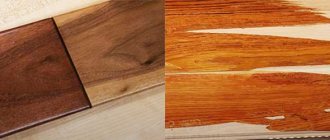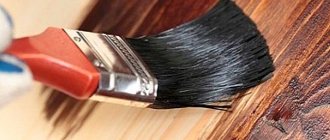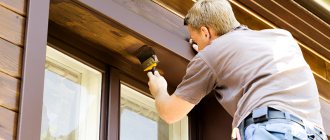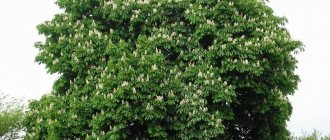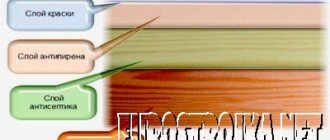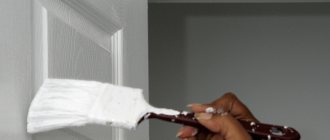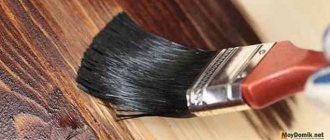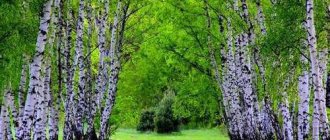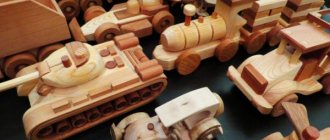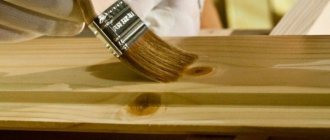Articles
All photos from the article
When finishing wooden surfaces, people often choose to paint the wood instead of applying colored impregnation and a layer of clear varnish. The appearance will be no worse, it is only important to choose the right type of paint and its shade, and there are a lot of nuances in this matter.
Wood processing
Aquatex Extra Rosewood
AQUATEX EXTRA® is a modern protective texture coating for wood. When creating it, the latest achievements, technologies and developments in the field of organic synthesis, light stabilization of polymers and microbiology were used. Due to its properties, AQUATEX EXTRA® can be used as a decorative coating on wood for exterior use.
Purpose
For decorative finishing of valuable species and reliable conservation of all types of wood indoors and outdoors. Strengthens the wood surface, preventing cracking. Protection of wood from atmospheric influences, UV radiation, from the formation of mold, blue stains and mildew.
Application area
New or previously treated wooden surfaces with alkyd protective agents: windows, frames, doors, walls, balconies, railings, loggias, platbands, shutters, baseboards, house facades, stairs, fences, garden buildings, furniture, products made of chipboard, fiberboard, plywood and etc.
PROPERTIES
- contains a hard-to-wash antiseptic;
- contains a UV filter of A and B ranges; the system of light stabilizers of this composition includes organic UV absorbers and new generation UV-absorbing nanopigments, which makes it possible to achieve high resistance to fading of the coating;
- deeply absorbed into wood;
- contains natural oils - increased elasticity of the coating;
- unlike wood paint, the texture of the wood is not hidden;
- contains microwax - enhanced water-repellent properties;
- thixotropic - easy to apply, does not drip from the tool during application;
- forms a silky-glossy, noble varnish coating.
Surface preparation
Stir wood paint before use Apply wood paint (stirring occasionally) to clean, air-dry wood, free of old coatings and damaged layers.
Can be applied to surfaces previously treated with drying oil and other wood preservatives.
In damp rooms, as well as to enhance antiseptic activity and additional protection against wood-destroying insects, it is recommended to pre-prime the wood with Aquatex-Grunt Antiseptic®.
Application
Apply wood paint with a brush, roller or spray gun in 1 or 2 layers with intermediate drying between layers of 12 hours. Painting is also used by dipping; if necessary, diluted with white spirit. When decorating interiors, it is recommended to apply two layers of paint with intermediate sanding with moisture-resistant fine sandpaper.
Final drying
Complete drying time at 20°C is 24 hours.
Working conditions
The ambient air and surface temperature must not be lower than +5°C
Coating colors
15 basic colors. All colors of the composition can be mixed with each other. The shade and intensity of the color of the coating largely depend on the type of wood, the quality of the surface treatment and the number of layers applied.
Cleaning the instrument
Cleaning of the instrument should be carried out using white spirit, kerosene, solvents 646, 647.
General information
The composition "Aquatex-extra"® (TU 2389-043-13238275-2006) is a pigmented solution of alkyd resins and target additives in organic solvents. The composition forms a breathable, bioprotective, moisture-repellent polymer coating on the surface of the wood .
"Aquatex-extra"® preserves or enhances the wood texture and gives it the desired shade. Compared to other similar compositions, it has increased resistance to fading and bioprotective activity, and is used as a wood paint for exterior use.
The composition is approved for use by the “Territorial Directorate of the Federal Service for Supervision of Consumer Rights Protection and Human Welfare in Moscow.”
CONSUMPTION
- for planed wood: 1 liter per 10 – 15 m2;
- for sawn wood: 1 liter per 5 – 8 m2.
Storage conditions
Store at temperatures from -40°C to + 40°C in a filled, sealed container away from heating and heating devices. Do not expose to open flame. Does not lose properties when frozen.
Best before date
3 years from date of manufacture
Source: https://www.kraski-ug.ru/katalog/dekorativnye-fasad-zabor-vagonka-i-td/p155
Rosewood: wood description, photo, color and texture
Rosewood includes several species of Jacaranda trees belonging to the Bignoniaceae family and Dalbergia species of the legume family, the wood of which is considered precious. These species are sometimes called rosewood, which is an imprecise descriptive name.
Rosewood tree species
Rosewood is a special type of wood, characterized by high hardness, resistance to the negative effects of external factors and pests, wear resistance, decorative and aesthetic qualities. This material is among the rarest and most expensive in the world. Trees that produce it grow in some countries of the Middle East, Indonesia, India, and South America.
A characteristic feature of these trees is considered to be extremely slow growth - a full-fledged mature trunk takes about 200 years to form, which does not allow for the rapid breeding of these valuable species. In diameter, such species reach from 30 to 150 cm, the average height is up to 12–25 m. Broad-leaved species of Dalbergia are planted on plantations or near the terraces of houses to create shade.
Freshly cut logs emit a specific, pleasant floral aroma of essential oil, which evaporates some time after processing. Widespread wastefulness and great demand for rosewood led to the almost complete disappearance of many varieties of trees. In the past, the refined taste of connoisseurs did not allow even the slightest green shades in the finished material; if a defect was suspected, such parquet was mercilessly destroyed.
Considering that it takes many centuries for valuable trees to be restored, it is understandable why they have become rare and protected by law. Many breeds are prohibited from being exported from the countries in which they grow.
Types, properties and qualities of wood
Rosewood is a sound wood type. The sapwood of these species is thin - from 3 to 15 cm, depending on the diameter of the trunk, has a whitish or light yellow color and is valued much lower, since it does not have the necessary technical and decorative qualities.
The core color varies from golden to brick, burgundy or dark chocolate, and often has contrasting purple or darker veining. The color range of “rosewood” is diverse. It has been noticed that older rosewood is darker; over time, its color can become even more saturated.
The wood has almost no shine; its natural surface is matte. The structure is coarse-fiber, almost uniform.
Types of rosewood differ depending on the type of wood. The most famous include the following:
- Indian rosewood - from the variety Dalbergia latifolia, growing on the Hindustan Peninsula, it is grown on special plantations, the popular trade name is sonokeling;
- royal - made from Brazilian jacaranda violetta wood, which is valuable for making crafts;
- cocobolo from the “Dalbergia retusa” breed of Mexican or Panamanian origin, distinguished by the ability to shift shades in the product, is extremely rarely found on the open market;
- Amazonian rosewood is of Brazilian origin, sometimes found in industry in limited quantities.
In terms of hardness and strength, rosewood is almost 1.5 times superior to oak and resembles ebony. Fresh wood is dried quickly and gently to avoid the appearance of surface cracks. Volumetric shrinkage is small, about 8%. After treatment, the hardness of the material doubles. Its density is from 800 to 1000 kg/cubic. m.
Rosewood is very difficult to saw, cut, drill and turn with hand and mechanical tools, which is the reason for frequent dulling and breaking of working surfaces. The wood owes this quality to the high content of lime deposits in the fibers. In this respect, wood is similar to ivory.
The material practically does not need painting or etching, as it is unique in itself. A popular method of surface treatment is priming with colorless compounds and polishing with various high-quality waxes, giving it a soft shine and emphasizing its nobility. The material tolerates gluing well. The fasteners in wood, due to their strength and hardness, hold perfectly.
Both solid wood and valuable wood veneer are successfully used. By using different cutting directions, the material is used to produce products that are magnificent in richness and design.
The biostability of rosewood is one of the best. Neither fungus, nor bark beetles, nor termites are capable of infecting precious wood, they are unable to cope with it.
Design Features
Rosewood doors can be dark or light. In any case, they will make the room more luxurious and elegant.
Art Deco style rosewood door
Arched rosewood door
Dark ones are practical, non-marking, but visually reduce the space, making it gloomy. Suitable for large, well-lit rooms. They look organic with a light floor. Platbands, baseboards, curtains are chosen to match the door leaf.
Rosewood sideboard
The dark brown color scheme in the interior is balanced by light warm shades.
Black rosewood door
Light veneered doors will ennoble and enlarge even the smallest space. They go well with standard double-glazed windows, but poorly with dark floors.
Rosewood door in a classic interior
For a calm, noble tree, it is desirable to add bright accessories in a contrasting color to the interior. Wallpaper needs to be appropriate: vinyl or silk in neutral light colors. There may be contrasting ones, but a balanced choice is required.
Acrylic impregnating varnish with antiseptic for wood and stone
| NAME | COLOR | WEIGHT | QUANTITY | PRICE | |
| NAME Acrylic impregnation varnish with antiseptic “B/TSVETN” (alb 2008), 0.9 kg (6 pcs) | COLOR | WEIGHT0.9 kg | QUANTITY | PRICE196 ₽ | Order |
| NAME Acrylic impregnation varnish with antiseptic “B/TSVETN” (alb 2008), 2.2 kg (4 pcs each) | COLOR | WEIGHT2.2 kg | QUANTITY | PRICE476 ₽ | Order |
| NAME Acrylic impregnation varnish with antiseptic “B/TSVETN” (alb 2008), 9 kg | COLOR | WEIGHT9 kg | QUANTITY | PRICE1 791 ₽ | Order |
| NAME Acrylic impregnation varnish with antiseptic “WHITE” (alb 2008), 0.9 kg (6 pcs) | COLOR | WEIGHT0.9 kg | QUANTITY | PRICE219 ₽ | Order |
| NAME Acrylic impregnation varnish with antiseptic “WHITE” (alb 2008), 2.2 kg (4 pcs each) | COLOR | WEIGHT2.2 kg | QUANTITY | PRICE534 ₽ | Order |
| NAME Acrylic impregnation varnish with antiseptic “WHITE” (alb 2008), 9 kg | COLOR | WEIGHT9 kg | QUANTITY | PRICE2 021 ₽ | Order |
| NAME Acrylic impregnation varnish with antiseptic “WENGE” (alb. 2008), 2.2 kg (4 pieces each) | COLOR | WEIGHT2.2 kg | QUANTITY | PRICE534 ₽ | Order |
| NAME Acrylic impregnation varnish with antiseptic “WENGE” (album 2008), 0.9 kg (6 pcs) | COLOR | WEIGHT0.9 kg | QUANTITY | PRICE219 ₽ | Order |
| NAME Acrylic impregnation varnish with antiseptic “CHERRY” (alb 2008), 0.9 kg (6 pcs) | COLOR | WEIGHT0.9 kg | QUANTITY | PRICE219 ₽ | Order |
| NAME Acrylic impregnation varnish with antiseptic “CHERRY” (alb 2008), 2.2 kg (4 pieces each) | COLOR | WEIGHT2.2 kg | QUANTITY | PRICE534 ₽ | Order |
| NAME Acrylic impregnation varnish with antiseptic “CHERRY” (alb 2008), 9 kg | COLOR | WEIGHT9 kg | QUANTITY | PRICE2 021 ₽ | Order |
| NAME Acrylic impregnation varnish with antiseptic “OAK LIGHT GRAY” (alb 2008), 0.9 kg (6 pcs) | COLOR | WEIGHT0.9 kg | QUANTITY | PRICE219 ₽ | Order |
| NAME Acrylic impregnation varnish with antiseptic “OAK LIGHT GRAY” (alb 2008), 2.2 kg (4 pcs each) | COLOR | WEIGHT2.2 kg | QUANTITY | PRICE534 ₽ | Order |
| NAME Acrylic impregnation varnish with antiseptic “OAK LIGHT GRAY” (alb 2008), 9 kg | COLOR | WEIGHT9 kg | QUANTITY | PRICE2 021 ₽ | Order |
| NAME Acrylic impregnation varnish with antiseptic “OAK” (alb 2008), 0.9 kg (6 pcs) | COLOR | WEIGHT0.9 kg | QUANTITY | PRICE219 ₽ | Order |
| NAME Acrylic impregnation varnish with antiseptic “OAK” (alb 2008), 2.2 kg (4 pcs each) | COLOR | WEIGHT2.2 kg | QUANTITY | PRICE534 ₽ | Order |
| NAME Acrylic impregnation varnish with antiseptic “OAK” (alb 2008), 9 kg | COLOR | WEIGHT9 kg | QUANTITY | PRICE2 021 ₽ | Order |
| NAME Acrylic impregnation varnish with antiseptic “KALUZHNITSTA” (alb 2008), 0.9 kg (6 pcs) | COLOR | WEIGHT0.9 kg | QUANTITY | PRICE219 ₽ | Order |
| NAME Acrylic impregnation varnish with antiseptic “KALUZHNITSTA” (alb 2008), 2.2 kg (4 pcs each) | COLOR | WEIGHT2.2 kg | QUANTITY | PRICE534 ₽ | Order |
| NAME Acrylic impregnation varnish with antiseptic “KALUZHNITSA” (alb 2008), 9 kg | COLOR | WEIGHT9 kg | QUANTITY | PRICE2 021 ₽ | Order |
| NAME Acrylic impregnation varnish with antiseptic “MAHOGANY TREE” (album 2008), 0.9 kg (6 pcs) | COLOR | WEIGHT0.9 kg | QUANTITY | PRICE219 ₽ | Order |
| NAME Acrylic impregnation varnish with antiseptic “MAHOGANY TREE” (album 2008), 2.2 kg (4 pieces each) | COLOR | WEIGHT2.2 kg | QUANTITY | PRICE534 ₽ | Order |
| NAME Acrylic impregnation varnish with antiseptic “MAHOGANY TREE” (album 2008), 9 kg | COLOR | WEIGHT9 kg | QUANTITY | PRICE2 021 ₽ | Order |
| NAME Acrylic impregnation varnish with antiseptic “MAHAGON” (alb 2008), 0.9 kg (6 pcs) | COLOR | WEIGHT0.9 kg | QUANTITY | PRICE219 ₽ | Order |
| NAME Acrylic impregnation varnish with antiseptic “MAHAGON” (alb 2008), 2.2 kg (4 pcs each) | COLOR | WEIGHT2.2 kg | QUANTITY | PRICE534 ₽ | Order |
| NAME Acrylic impregnation varnish with antiseptic “MAKHAGON” (alb 2008), 9 kg | COLOR | WEIGHT9 kg | QUANTITY | PRICE2 021 ₽ | Order |
| NAME Acrylic impregnation varnish with antiseptic “WALNUT TREE” (album 2008), 0.9 kg (6 pcs) | COLOR | WEIGHT0.9 kg | QUANTITY | PRICE219 ₽ | Order |
| NAME Acrylic impregnation varnish with antiseptic “WALNUT TREE” (album 2008), 2.2 kg (4 pieces each) | COLOR | WEIGHT2.2 kg | QUANTITY | PRICE534 ₽ | Order |
| NAME Acrylic impregnation varnish with antiseptic “WALNUT TREE” (album 2008), 9 kg | COLOR | WEIGHT9 kg | QUANTITY | PRICE2 021 ₽ | Order |
| NAME Acrylic impregnation varnish with antiseptic “ROSEWOOD” (alb. 2008), 0.9 kg (6 pcs) | COLOR | WEIGHT0.9 kg | QUANTITY | PRICE219 ₽ | Order |
| NAME Acrylic impregnation varnish with antiseptic “ROSEWOOD” (alb. 2008), 2.2 kg (4 pcs each) | COLOR | WEIGHT2.2 kg | QUANTITY | PRICE534 ₽ | Order |
| NAME Acrylic impregnation varnish with antiseptic “ROSEWOOD” (alb. 2008), 9 kg | COLOR | WEIGHT9 kg | QUANTITY | PRICE2 021 ₽ | Order |
| NAME Acrylic impregnating varnish with antiseptic “PINE” (alb 2008), 0.9 kg (6 pcs) | COLOR | WEIGHT0.9 kg | QUANTITY | PRICE219 ₽ | Order |
| NAME Acrylic impregnation varnish with antiseptic “SOSN” (alb 2008), 2.2 kg (4 pcs each) | COLOR | WEIGHT2.2 kg | QUANTITY | PRICE534 ₽ | Order |
| NAME Acrylic impregnation varnish with antiseptic “SOSN” (alb 2008), 9 kg | COLOR | WEIGHT9 kg | QUANTITY | PRICE2 021 ₽ | Order |
| NAME Acrylic impregnation varnish with antiseptic “TIK” (alb 2008), 0.9 kg (6 pcs) | COLOR | WEIGHT0.9 kg | QUANTITY | PRICE219 ₽ | Order |
| NAME Acrylic impregnation varnish with antiseptic “TIK” (alb 2008), 2.2 kg (4 pcs each) | COLOR | WEIGHT2.2 kg | QUANTITY | PRICE534 ₽ | Order |
| NAME Acrylic impregnation varnish with antiseptic “TIK” (alb 2008), 9 kg | COLOR | WEIGHT9 kg | QUANTITY | PRICE2 021 ₽ | Order |
| NAME Acrylic impregnation varnish with antiseptic “WENGE”, 9 kg | COLOR | WEIGHT9 kg | QUANTITY | PRICE2 021 ₽ | Order |
Click on a color to select the amount of tinting and add it to your cart!
Aqueous dispersion of acrylic copolymer, antiseptic and modifying additives, pigment.
Any wooden surface needs protection. Constant exposure to moisture and other negative factors causes swelling of the fibers, deformation of the product, and the development of rot and fungi. Acrylic varnish for wood from TM VGT is intended for deep impregnation and protection of wooden surfaces (except floors) from rotting.
It is also used for decorative finishing and protection of brick, concrete and other mineral bases, as well as natural and artificial stone from fungi, algae, and mold. The varnish can be used for external and internal woodwork in all types of buildings and structures (A-B), including those for which a wet disinfection mode is provided.
The main advantages of wood varnish
- Forms a transparent, elastic, durable film. The varnish is resistant to cracking even with slight deformations of the base.
- It has a greater depth of penetration into the wood structure, which provides longer protection against rotting.
- It is universal for external and internal work.
- Preserves the richness of the color of the decorative coating or the wood itself. The composition is made with a UV filter.
- Available in a wide range of colors. Wood varnishes are offered in 12 colors.
- Excellent steam permeability, preventing moisture from being retained in the fibers. A “breathable” coating is formed, which helps maintain a comfortable indoor microclimate.
What colors are your priority?
Is your home your face? Furniture will show your character! White color speaks of your aristocracy, luxurious shades of dark and mahogany wood speak of your solidity, light colors of birch furniture indicate your optimism! Therefore, if you prefer traditions, classics and are not afraid of the word conservative - do not experiment, choose furniture in warm, rich colors - walnut, oak, mahogany. If, on the contrary, you strive to go ahead of everyone, ahead of ideas and technologies, opt for the light, aristocratic colors of birch, pine, ash, and maple.
Rosewood wood paint color and other popular shades
All photos from the article
When finishing wooden surfaces, people often choose to paint the wood instead of applying colored impregnation and a layer of clear varnish. The appearance will be no worse, it is only important to choose the right type of paint and its shade, and there are a lot of nuances in this matter.
Wood processing
What type of paint to choose
Durability, bright color of the coating and the painting technology itself largely depend on the type of paint and varnish materials.
You will have to choose between such types of coatings as:
- acrylic - in many respects considered the best choice on the market. The pores in the wood are not clogged, the wood continues to breathe, and the coating has excellent resistance to moisture. The lifespan is from 5 to 10 years, after which the coating will have to be renewed;
Acrylic paint
Note! Artistic paints for wood are most often acrylic, rather than oil or alkyd. There is no need to be afraid that the applied pattern will peel off over time.
- alkyd coatings - can be used in cases where it is necessary for the coating to dry as quickly as possible. This also has a downside - the film of paint on the surface of the wood is very thin, and it is not deeply absorbed into the wood;
- oil-based coatings can be considered a classic; they appeared quite a long time ago; ordinary drying oil is used as a solvent. It is impossible to confuse oil paint with any other, if only because of the specific pungent and unpleasant odor.
The price of oil paint is slightly higher than alkyd and acrylic paint, and the painting process itself will take longer (after all, 1 layer dries in about 24 hours). But the coating is durable and resistant to climatic factors.
In the photo - universal oil paint
Also, when choosing, you should pay attention to the purpose of the paint:
- compositions for interior work should under no circumstances be used for painting, for example, the facade of a house or a wooden fence. For example, black wood paint for interior work may have poor resistance to UV rays and low temperatures, so that outside it will not require updating after the first winter;
- Paintwork materials for outdoor use are characterized by increased resistance to UV radiation, and they can also withstand low temperatures without problems;
- As for artistic paints, shade matching and other subtleties play a big role here.
Artistic paints are available in small tubes
Color also plays a role
The color palette of paints from any manufacturer includes dozens or even hundreds of shades; choosing the right one is not an easy task. Sometimes, for the convenience of searching and so that a person can at least roughly imagine the shade, the name of a tree of a certain species is entered into the product designation. For example, paint for rosewood wood means that its color is brown in different shades.
Light shades
Using tinted wood impregnation, you can get bleached wood. In this case, the liquid does not “clog” the wood texture, but the color of the surface becomes light. This type of wood processing with a pronounced texture looks especially impressive.
Bleached wood is obtained by impregnation
You won’t be able to get the desired shade with just white; you will need a primer and varnish. The key point in this case is the preparation of the wood itself. Its surface should not be perfectly smooth, only in this case the lower places will be dark and the convex places will be light.
Painting instructions will look like this:
- A primer is applied to the prepared surface; uneven application will only be beneficial;
- after it dries, apply 2 layers of varnish;
- the final stage is tinting the varnish with white enamel. In this case, paint for bleached oak wood is applied little by little; the surface should not be perfectly white; ideally, a dark base is visible through the enamel layer - this is classic bleached oak.
White enamel gives a slightly different effect
Of the light shades, ivory color is worth highlighting; it ennobles any room and has a calming effect on a person. The easiest way is to purchase the desired shade, but the store often simply does not have the desired color. In this case, you can start mixing different colors yourself.
The combination of light color and fired surface gives an interesting effect
To obtain any shade of ivory you will need white paint, as well as ocher and dark brown. The manufacturing process is extremely simple - the main color is white, ocher and a dark brown tint are gradually added to it.
Ivory wood paint will take on a cold, austere hue if the main focus is on dark brown, but ocher, on the contrary, adds warmth and softness to the color. The main thing is not to rush and experiment with small volumes to create a proportion.
Mother of pearl and gold
Gold paint on wood can turn even a nondescript piece of wood into a real jewel. Of course, the deception will be revealed if you touch the product or evaluate its weight, but in appearance it will be very similar to real gold.
Wooden "gold"
The composition of this paint differs from the usual one in the presence of small metal particles, which give it the desired color and shine. Of course, it is not real gold that is used for this, but other metals (bronze, brass, etc.).
Among the peculiarities of painting wood with gold, we can note the need to secure the layer with a transparent varnish. If this is not done, the “gold” layer will be erased quite quickly. Gold wood paint can be produced both in the form of sprays and in liquid form in cans.
You can always buy the desired color
Note! Securing with varnish is advisable in any case. In addition to making the surface impervious to abrasion, the varnish also increases the shine of the gold.
As for making gold paint with your own hands, the main difficulty here is to obtain sufficiently small metal particles and select their optimal concentration in the paint. Considering the availability of gold, silver, bronze paints, it is easier to simply buy the desired color than to try to get it yourself.
In addition to imitation of gold, silver and other metals, pearlescent paint will look original in the house, which changes shade depending on the lighting and the direction of view.
Decorative pearlescent paint
This effect is achieved by introducing mica particles into the paint, which give such an unusual effect. If pearlescent wood paint is applied according to all the rules, then such a coating is considered to be three-layer. Moreover, when working with mother-of-pearl coatings, the concept of hiding power is somewhat inappropriate.
If ordinary paint is applied until the surface acquires a uniform color, then with mother-of-pearl there is no such requirement. A transparent varnish is applied on top of the layer - a protective layer.
Imitation of valuable wood species
Often, you only have an ordinary smooth pine board on hand, and extra expenses on purchasing valuable types of wood are impossible. In this case, you can try to imitate the texture of some valuable species, although achieving 100% similarity is not always possible.
Rosewood
The color range of rosewood wood varies depending on the variety. The main background is from pinkish-light brown to brick-red or chocolate-brown. The pattern consists of dark veins, often with a purple tint.
Most rosewoods of the genus Dalbergia, due to the high content of essential oils in freshly cut wood, have a pleasant floral aroma, which, unfortunately, disappears after drying.
The hardness of this material is twice that of oak, it has high strength and is easy to polish.
In addition to being used in solid wood, very attractive veneer is made from rosewood wood, the pattern of which often depends on the choice of planing direction, which makes it possible to select quite exquisite patterns. Wood is used in the manufacture of furniture, parquet, musical instruments, and billiard cues.
High-quality furniture and parquet are made from this material. As a decorative wood with a high variety of shades, it is used in the interior of expensive carriages, cabins and liners. Due to its stability and durability, it is excellent for the production of doors, window frames, carved furniture, chess, canes, umbrella handles, cases, and guitars. Rosewood is the main material for the production of xylophone keys.
Being several times harder than oak, solid rosewood boards do not require special care, and the variety of shades, colors and cut patterns can satisfy even the most demanding customers. The large amount of oil in rosewood wood makes it possible to choose between a solid board that is varnished and a natural solid board made of rosewood without coating. A durable, high-quality, unsurpassably beautiful floor, which is covered with a massive rosewood board, can delight you for centuries.
Areas of application of rosewood
Rosewood, due to its unique hardness, is ideal for carving. Because of this, carvers make unusually beautiful things from it, many of which are real works of art.
Umbrellas and canes with graceful handles made from this exotic wood look great. Carved jewelry and cigar boxes are considered chic gifts. Expensive musical instruments with a unique sound are made from rosewood.
In furniture production, rosewood wood is used to make luxury exotic furniture.
Parquet made from it is used to create luxurious exclusive interiors. Rosewood core wood is used for parquet. A distinctive feature of parquet and solid boards is the variety of color shades. This allows you to create a wide variety of unique floor covering designs.
During installation, oil or varnish is used to finalize the surface of the floor covering. In rooms well illuminated by sunlight, flooring made of this material tends to lighten over time. But the attractiveness of its appearance is not lost at all. An elite solid board is made from a single piece of wood. At the request of the customer, it can be coated with varnish, or it can be left uncoated.
Types of rosewood
- Dalbergia latifolia - Also known as Indian rosewood , Javanese rosewood, Indonesian rosewood, Bombay ebony, Malabar and Sonokeling. Found in India, Pakistan, Sri Lanka and Indonesia.
- Sissoo - Dalbergia sissoo - another species of the same genus from India, which in trade practice is usually no different from Indian rosewood and goes under the same names.
- Siamese rosewood - Dalbergia cochinchinensis, also known as 'firewood' or chak, or Burmese rosewood - Dalbergia olivera - also called Burmese tulip tree, and a number of others from Cambodia - Dalbergia cultrata, camlay from Vietnam - Dalbergia bariensis). They are quite rare on the market as independent breeds.
- Rio rosewood - Dalbergia nigra - Brazilian rosewood, Brazilian rosewood, Rio jacaranda, jacaranda da Bahia, preto jacaranda, caviuna jacaranda, pau preto, rosewood de Segippe. The range is limited to Brazil; currently the breed is rare and protected. Not to be confused with the "just" Brazilian tree - Caesalpinia echinata, which is more accurately called "Brazilian ironwood".
- Queen tree - Dalbergia cearensis - also Brazilian king tree, purple tree, jacaranda violeta, pau violeta. Native to eastern Brazil, it is so named because of its popularity at the courts of Louis XIV and Louis XV. The main area of application today is inlay, marquetry, small turnings, etc. “Purple wood” can also be called another South American species, amaranth, also known as purpleheart - Peltogyne paniculata, P. pubescens.
- Cocobolo - Dalbergia retusa - also granadillo, Nicaraguan rosewood, Central American rosewood, nambar, palo negro, funera, salamander rosewood, coral rosewood.
- Honduran rosewood - Dalbergia stevensonii and Dalbergia tucerensis - are also Central American rosewood. Area: Central America.
- Brazilian tulip tree - Dalbergia frutescens - also pau rose, jacaranda rose, pau de fuso, pinkwood, bois de rose, Baia rosewood. The name most likely refers to the smell of freshly cut wood.
- Amazonian Rosewood - Dalbergia spruceana - Amazonian rosewood, Jacaranda do Pará grows in northeastern Brazil. It resembles Rio rosewood, but differs from it in smell and microstructure.
- There are other species of Dalbergia in South America, including the commercially used Dalbergia glomerata from Central America), but all these species are rare in nature and very rarely found on the market. However, as singular offerings one can find, for example, camatillo - Dalbergia congestiflora - also known as the king tree of Para and the Mexican king tree.
Shrinkage
| Very low | Low | Average | High | Very high |
| Tangential | ✓ | |||
| Radial | 0 — 2 |
Voltage
| Structural No. 1 | Structural No. 2 | Structural No. 3 | Structural No. 4 | Structural No. 5 | |
| Not dried | F14 | F11 | F8 | F7 | F5 |
| Dried | F17 | F14 | F11 | F8 | F7 |
Standard Density
| Not dried | 0 kg/m³ |
| Dried | 650 kg/m³ |
Application
The scope of use of rosewood, despite its unique qualities, is narrow. Rarity and high cost have long made this material not accessible to everyone. It was used to make piece parquet in palaces and houses of the nobility, parts of musical instruments, furniture elements, interior wall decoration, figurines, carved collectible chess sets, boxes, and jewelry. Artists used rosewood plates as a source material for creating miniatures. It can serve for hundreds of years without deforming, drying out, or succumbing to damage or rotting.
In the modern world, the scope of application of this valuable material can be considered the production of finishing in top-class vehicles: limousine interiors, cabins of yachts and liners. The bodies and necks of expensive guitars are made from rosewood, and the handles of collectible knives are turned.
Despite the enviable strength, moisture resistance and other excellent characteristics necessary in construction, there is, of course, no need to talk about the widespread use of rosewood in it. It’s hard to even imagine how much it would cost to install window frames in a house or lay floors from it. Wood is used as a valuable ornamental material and is a constant indicator of luxury and refined taste for owners of any items made from it.
Taking advantage of the fact that rosewood is a desirable material for collectors and lovers of luxury, swindlers selling wood pass off cheaper species as valuable species: Bolivian rosewood, wenge, masasuba, chechem, culupai and other tropical varieties. A true connoisseur who deals with rosewood in practice can distinguish the imitation from the original. Based only on the structure and color scheme of lumber, you can easily be deceived. Externally, expensive and cheap breeds are similar, but the quality and durability of the latter are noticeably lower.
True rosewood is becoming so rare due to many circumstances that it is found only in shadow markets or in Asian or South American stores in places where the trees grow. In Europe, parquet boards and other rosewood finishing materials are officially prohibited for sale. The danger of extinction of valuable species plays a significant role in this.
